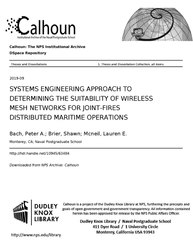File:SYSTEMS ENGINEERING APPROACH TO DETERMINING THE SUITABILITY OF WIRELESS MESH NETWORKS FOR JOINT-FIRES DISTRIBUTED MARITIME OPERATIONS (IA systemsengineeri1094563484).pdf

Original file (1,275 × 1,650 pixels, file size: 3.18 MB, MIME type: application/pdf, 116 pages)
Captions
Captions
Summary[edit]
| SYSTEMS ENGINEERING APPROACH TO DETERMINING THE SUITABILITY OF WIRELESS MESH NETWORKS FOR JOINT-FIRES DISTRIBUTED MARITIME OPERATIONS
( |
||
|---|---|---|
| Author |
|
|
| Title |
SYSTEMS ENGINEERING APPROACH TO DETERMINING THE SUITABILITY OF WIRELESS MESH NETWORKS FOR JOINT-FIRES DISTRIBUTED MARITIME OPERATIONS |
|
| Publisher |
Monterey, CA; Naval Postgraduate School |
|
| Description |
This capstone explored options for two different communications architectures in support of a distributed maritime operation (DMO). Those architectures were the star and wireless mesh networks. The purpose of the scenario models developed for this study was to help give the reader a better understanding of how the tightly coupled data type, data rate, and desired network capabilities impact the network design. This study evaluated each architecture against a variety of assets in the scenarios requiring a combination of video, voice, and data links. It provided insight into the messaging delays inherent to each design and evaluated the reliability of each network. It found that a star and mesh network with a low Earth orbit satellite that utilized onboard routing capabilities provided the lowest timing delay. It also found that network jitter was minimized when a video feed was provided with a dedicated channel. Finally, the reliability of the mesh network was slightly higher than that of the traditional star due to redundancy of data links and a lack of a potentially vulnerable central hub. Therefore, the utilization of an ad hoc wireless mesh communications network will support the deployment of an adaptive force package during a limited offensive joint fires strike in a DMO. Subjects: joint fires; DMO; distributed maritime operations; systems engineering; reef island; mesh networks; Littorals |
|
| Language | English | |
| Publication date | September 2019 | |
| Current location |
IA Collections: navalpostgraduateschoollibrary; fedlink |
|
| Accession number |
systemsengineeri1094563484 |
|
| Source | ||
| Permission (Reusing this file) |
This publication is a work of the U.S. Government as defined in Title 17, United States Code, Section 101. Copyright protection is not available for this work in the United States. | |
Licensing[edit]
| Public domainPublic domainfalsefalse |
This work is in the public domain in the United States because it is a work prepared by an officer or employee of the United States Government as part of that person’s official duties under the terms of Title 17, Chapter 1, Section 105 of the US Code.
Note: This only applies to original works of the Federal Government and not to the work of any individual U.S. state, territory, commonwealth, county, municipality, or any other subdivision. This template also does not apply to postage stamp designs published by the United States Postal Service since 1978. (See § 313.6(C)(1) of Compendium of U.S. Copyright Office Practices). It also does not apply to certain US coins; see The US Mint Terms of Use.
|
 | |
| This file has been identified as being free of known restrictions under copyright law, including all related and neighboring rights. | ||
https://creativecommons.org/publicdomain/mark/1.0/PDMCreative Commons Public Domain Mark 1.0falsefalse
File history
Click on a date/time to view the file as it appeared at that time.
| Date/Time | Thumbnail | Dimensions | User | Comment | |
|---|---|---|---|---|---|
| current | 02:01, 25 July 2020 |  | 1,275 × 1,650, 116 pages (3.18 MB) | Fæ (talk | contribs) | FEDLINK - United States Federal Collection systemsengineeri1094563484 (User talk:Fæ/IA books#Fork8) (batch 1993-2020 #28848) |
You cannot overwrite this file.
File usage on Commons
The following page uses this file:
Metadata
This file contains additional information such as Exif metadata which may have been added by the digital camera, scanner, or software program used to create or digitize it. If the file has been modified from its original state, some details such as the timestamp may not fully reflect those of the original file. The timestamp is only as accurate as the clock in the camera, and it may be completely wrong.
| Short title | SYSTEMS ENGINEERING APPROACH TO DETERMINING THE SUITABILITY OF WIRELESS MESH NETWORKS FOR JOINT-FIRES DISTRIBUTED MARITIME OPERATIONS |
|---|---|
| Author | Bach, Peter A., Brier, Shawn, Mcneil, Lauren E. |
| Software used | Bach, Peter A., Brier, Shawn, Mcneil, Lauren E. |
| Conversion program | Adobe Acrobat Pro 11.0.23 |
| Encrypted | no |
| Page size |
|
| Version of PDF format | 1.4 |

